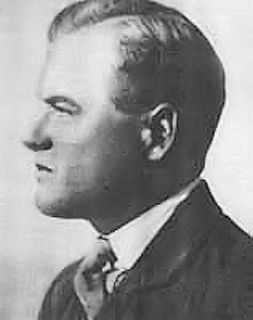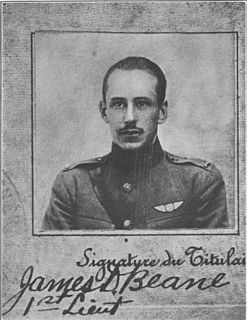
Michel Joseph Callixte Marie Coiffard was one of the leading French flying aces of World War I. He was notable for his success as a balloon buster shooting down enemy observation balloons, which were usually heavily defended by anti-aircraft machine guns and artillery and by fighter planes. He scored 34 victories in his career.

Léon Bourjade, born Jean-Pierre Léon Bourjade, was a leading French fighter pilot in World War I, notable for being his country's leading balloon-busting ace. He interrupted his theological studies to fight in World War I; post-war, he completed his studies and spent the few remaining years of his life as a missionary in what is now Papua New Guinea.

Joseph Frank Wehner, also known as Fritz Wehner, was an American fighter pilot and wingman to Frank Luke.

Major David McKelvey Peterson was a 1915 Lehigh University graduate who was a World War I flying ace with 6 aerial victories, one earned in the Lafayette Escadrille and five officially credited while with the United States Army Air Service. Born in Honesdale, Pennsylvania on July 2, 1894, he was killed in an aviation accident following the war in Daytona Beach, Florida on March 16, 1919.

Alfred Marie-Joseph Heurtaux was a French World War I fighter ace credited with 21 victories. Later in his life, he joined the French Resistance during World War II, and survived imprisonment in Buchenwald death camp to become a brigadier general in the post war Armée de l'Air.

Arthur Edmund Easterbrook was an American aviator who started his career as a World War I flying ace credited with five aerial victories. During World War II, he held several important positions in the U. S. Army Air Corps.

Lieutenant George Willard Furlow was a World War I flying ace credited with five aerial victories.
Sous Lieutenant Joseph-Henri Guiguet was a French World War I flying ace credited with five aerial victories.

Lieutenant James Knowles, Jr. was a World War I flying ace credited with five aerial victories. He was one of the final aces in the war.

Lieutenant James Dudley Beane was a World War I flying ace credited with six aerial victories.

Lieutenant Donald Hudson was an American World War I flying ace credited with six aerial victories. Postwar, he pioneered aviation in Bolivia, including being the first aviator to fly across the Andes Mountains.

Lieutenant William Thomas Ponder was an American World War I flying ace credited with six aerial victories.

Captain Gorman DeFreest Larner was a World War I flying ace credited with seven aerial victories.

Brigadier General Martinus Stenseth began his career in the Minnesota National Guard in June 1916, before the United States entered World War I. He remained in the military as a professional soldier, rising to the rank of brigadier general.

Lieutenant Clinton Leonard Jones, Jr. was an American World War I flying ace credited with eight aerial victories.
Sous Lieutenant Jacques Louis Ehrlich was a French World War I flying ace credited with 19 aerial victories; he was one of the leading balloon busters of the war.

Capitaine Albert Louis Deullin was a French World War I flying ace credited with twenty aerial victories. He served for the entirety of World War I. By war's end, he had risen to command of a fighter wing. He would die in a postwar flying accident.
Sous Lieutenant Jean Pie Hyacinthe Paul Jerome Casale, was a French World War I flying ace credited with thirteen aerial victories. He was one of the few aces that survived the entire course of fighter aviation in the war.

Lieutenant Frank Leaman Baylies was an American World War I flying ace credited with twelve aerial victories while flying in the French Aeronautique Militaire. Having originally volunteered for the Ambulance Corps, Baylies transferred into French aviation in May 1917. After scoring his 12 victories with the French, he transferred into American aviation service but remained with the French until his death in action.

Paul Frank Baer was an American fighter pilot for the United States Army Air Service in World War I. He was credited with nine confirmed victories and seven unconfirmed victory claims, making him the first flying ace in American military aviation history.

















